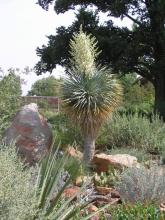
High Plains Gardening
The gardening website of the Texas High Plains Region

Yuccas for Texas High Plains Landscapes
There are many yuccas we can grow in the Texas Panhandle that are all low water-use. Those yuccas native to the southeastern United States can take medium water, while those native to the southwestern areas are quite drought tolerant. Soils for all these yuccas should have fairly good drainage. Avoiding overwatering in clay soil.
Cold Hardy Yuccas
As with most native southwestern plants, for decades it was assumed the cold hardiness of yucca were fairly warm blooded. However, these early cold hardiness ratings were issued by gardeners and botanic gardens from more moist winter climates. In soil with good drainage, less organic matter and our normal winter moisture, yucca are hardier than first thought.
The temperatures given below are all conservative. With good soil drainage they can winter over very nicely for us, many in a Zone 6 winter (down to -10°). Some of the yuccas are stemless, others single trunked or multiple trunked, most forming multiple clusters.
Roots of yuccas grow deep; propagation is by root divisions with the trunkless yuccas, as they are clump forming. Try to dig out as deep a section of root as possible, then nurse its growth along for a year before letting it on its own. I've not attempted propagation of the trunk forming yuccas.
Much of this information is taken from Mary and Gary Irish's book, Agaves, Yuccas and Related Plants, and from my own experience with them. For much more information on individual yucca species, click on Plant Lists, Yucca.
*Yucca aloifolia, Aloe yucca, SE native, different varieties including variegated, single stemmed or simple branched, cold hardy to 0°.
*Y. baccata, banana yucca, SW, small trunked, to -20°.
Y. brevifolia, Joshua Tree, largest yucca tree-form up to 30 feet or more, Mojave Desert, -10°.
Y. elata, soaptree yucca, 1- 10 trunks up to 6-15' tall, SW, state flower of New Mexico, -10°.
Y. faxoniana, Faxon's yucca, SW, 6-20', usually 1 trunk but up to 6' tall, 0°.
*Y. filamentosa, SE, many varieties including 'Color Guard','Gold Sword', 'Bright Lights', 'Blue Sword', ''Hairy”, up to about 3 ft., trunkless, -20°. I've grown all but the 'Blue Sword' variety. Needs medium water-use, benefits from afternoon shade (leaves are thinner).
Y. flaccida, SE, small, stemless up to 3 ft., -20°.
Y. glauca, (aka Y. angustifolia) soapweed yucca, our area native grows as far north as Canada, mostly stemless, -35°. I haven't grown it!
*Y. harrimaniae, Harriman's yucca, SW, very small, usually not more than 12 inches, to -20°.
*Y. pallida, native to blackland prairies of Texas, clumping, stemless with blue leaves, to 0°. I've grown them for about 8+ years.
*Y. recurvifolia, (aka Y. pendula) SE and Gulf Coast Plains, medium to tall, can have multiple trunks, 'Yellow Ribbons' is a new variety, to 0°.
*Y. rigida, SW, blue yucca, medium sized, single trunked with multiple stems to 15', to 5° (Zone 7b). I've grown it for 5+ years.
*Y. rostrata, beaked yucca, similar to Y. rigida but with narrower leaves, single trunked with multiple stems, blue leaves, very attractive, to 5° (Zone 7b), thriving at Amarillo Botanical Gardens since 2006.
*Y. rupicola, twisted leaf yucca, stemless, clumping, bright olive green leaves, native to the Edwards Plateau only, to 0°. Wintered over reliably for 6+ years.
*Y. schidigera, Mohave yucca, SW, single trunk or clustered multiple trunks, to 0°.
*Y. schottii, mountain yucca, medium single trunked to 6-15', SW, to -10°.
*Y. smalliana, (aka Y. filamentosa var smalliana), small up to 8-10 inches tall, variegated, from 0° to -10°.
*Y. thompsoniana, (aka Y. rostrata), SW, treelike, temperatures down to 0° to -10°.
Y. torreyi, Torrey yucca, treelike up to 24', SW, to 5° (Zone 7b).
Y. whipplei, Chaparral yucca, single rosette or clumps to 3-6', SW, to 0°.
*I have grown the yuccas noted with an asterisk in my landscape or in other landscapes I've designed. Yucca's can make good container plants for temperature sensitive species.
Yuccas are one of the plant genera that are what I term, southwest evergreens -- plants that provide that evergreen presence in our gardens. Sunny drought tolerant beds and borders. Native plant gardens. Rock garden (depending on species). Habitat garden. Southern garden. Xeric garden. The arborescent (tree-like) yuccas can be used as accent plants and focal points in the landscape. Yuccas work great in containers, whether they are cold hardy or non-cold hardy. Just be sure to move the containers inside during the winter.
Very little maintenance is needed. Cut off flower stalk in autumn or late winter.